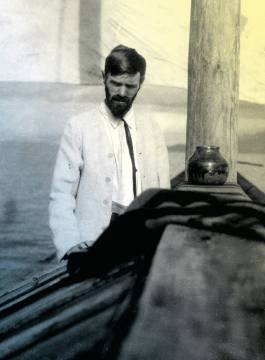Christine Smallwood in Bookforum:
 My relationship with D. H. Lawrence began in high school, when I bought a copy of Sons and Lovers more or less at random and proceeded to read it all the way through, by which I mean that my eyes literally traversed every page and recognized that the English language was there recorded in some complexity. But the words, instead of building a reality I could enter and move around in, were like a continually dying fluorescence. I had no idea what was going on. What registered was something like “words, words, flower, sentence, words, coal mining” (like I knew what a coal mine was). As far as I was concerned, Sons and Lovers appeared out of nothing and to nothing it returned. All I knew when I was finished was all I knew before I plucked it, more or less at random, off the shelf: that it was a “classic.”
My relationship with D. H. Lawrence began in high school, when I bought a copy of Sons and Lovers more or less at random and proceeded to read it all the way through, by which I mean that my eyes literally traversed every page and recognized that the English language was there recorded in some complexity. But the words, instead of building a reality I could enter and move around in, were like a continually dying fluorescence. I had no idea what was going on. What registered was something like “words, words, flower, sentence, words, coal mining” (like I knew what a coal mine was). As far as I was concerned, Sons and Lovers appeared out of nothing and to nothing it returned. All I knew when I was finished was all I knew before I plucked it, more or less at random, off the shelf: that it was a “classic.”
So it remained between me and D. H. Lawrence, a situation of somewhat ashamed incomprehension, until, in my twenties, I received a hardcover edition of The Rainbow as a gift from the shittiest boyfriend I ever had. Overnight I became a devotee of the cult of Lawrence. There is no life situation, for a heterosexual woman, that can prepare her so well to fall into a Lawrentian hole than a high-drama, mutually narcissistic, obsessive relationship with an inadequate man, no way that more prepares you to be seduced into what is seductive and to (eventually) resist what needs resisting, yet to hold on to a vision of a world of perfect, horrifying union between lovers—horrifying because it threatens the only thing that Lawrence believed was worth anything, the individual soul.
More here.
